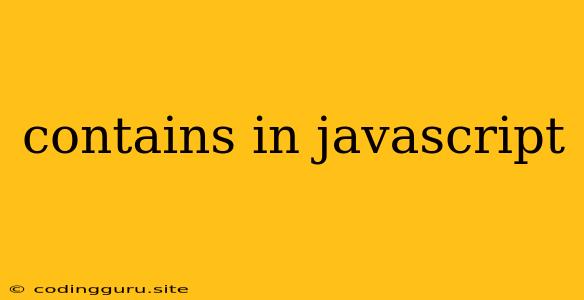Understanding the "contains" Concept in JavaScript
In the realm of JavaScript programming, the concept of "contains" arises frequently when you need to check if a particular element exists within a collection of data. This could be a string, an array, or even an object. While JavaScript doesn't have a direct "contains" method like some other languages, there are efficient ways to achieve this functionality. Let's delve into the most common methods and scenarios:
Strings: Checking for Substrings
The most basic form of "contains" in JavaScript is checking if a string contains a substring. This is accomplished using the includes() method:
const myString = "Hello, world!";
const containsWorld = myString.includes("world"); // true
const containsJavaScript = myString.includes("JavaScript"); // false
Important Note: The includes() method performs a case-sensitive search. If you want to check for a substring regardless of case, you can convert both the string and the substring to lowercase using toLowerCase():
const myString = "Hello, world!";
const containsWorld = myString.toLowerCase().includes("world".toLowerCase()); // true
Arrays: Searching for Elements
When dealing with arrays, JavaScript provides several methods to determine if an element is present:
- indexOf(): This method returns the index of the first occurrence of the element in the array. If the element isn't found, it returns -1.
const myArray = ["apple", "banana", "orange"];
const containsBanana = myArray.indexOf("banana") !== -1; // true
const containsGrape = myArray.indexOf("grape") !== -1; // false
- includes(): Similar to its string counterpart,
includes()returns a boolean value indicating whether the element exists in the array.
const myArray = ["apple", "banana", "orange"];
const containsApple = myArray.includes("apple"); // true
const containsGrape = myArray.includes("grape"); // false
Note: Both indexOf() and includes() work on primitive data types. For arrays containing complex objects, you'll need to iterate through the array and use a comparison method within the loop.
Objects: Checking for Key Existence
To check if an object contains a specific key, you can use the in operator:
const myObject = { name: "John", age: 30 };
const hasNameKey = "name" in myObject; // true
const hasOccupationKey = "occupation" in myObject; // false
Alternatively, you can use the hasOwnProperty() method to check if an object has a specific property:
const myObject = { name: "John", age: 30 };
const hasNameProperty = myObject.hasOwnProperty("name"); // true
const hasOccupationProperty = myObject.hasOwnProperty("occupation"); // false
Choosing the Right Method
The most appropriate method for checking "contains" depends on the data type you're working with.
- Strings: Use
includes()for case-sensitive checks ortoLowerCase()before usingincludes()for case-insensitive checks. - Arrays: Use either
indexOf()orincludes()depending on your preference. - Objects: Use
inorhasOwnProperty()to determine key existence.
Beyond the Basics: Custom "contains" Functions
For more complex scenarios or specific requirements, you might consider creating your own "contains" functions. For instance, you could create a function that checks if an array contains any elements that meet a specific condition.
function containsEvenNumbers(arr) {
for (let i = 0; i < arr.length; i++) {
if (arr[i] % 2 === 0) {
return true;
}
}
return false;
}
Conclusion
The "contains" concept is fundamental in JavaScript and arises in various contexts. Understanding the methods and techniques discussed in this article will equip you to confidently determine the presence of specific elements within strings, arrays, and objects. By choosing the appropriate method based on the data type and your specific requirements, you can efficiently and accurately check for "contains" in your JavaScript code.
